The Italian silent film La nave (1921) was based on the play by Gabriele D'Annunzio. His son Gabriellino D'Annunzio directed the film together with Mario Roncoroni. The Russian dancer and actress Ida Rubinstein was the star of Le nave.
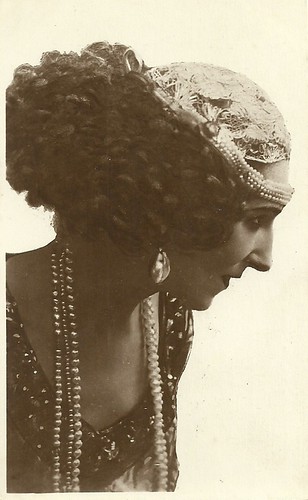
Ida Rubinstein. Italian postcard. Photo: Unione Cinematografica Italiana. Publicity still for La nave (Gabriellino D'Annunzio, Mario Roncoroni, 1921).
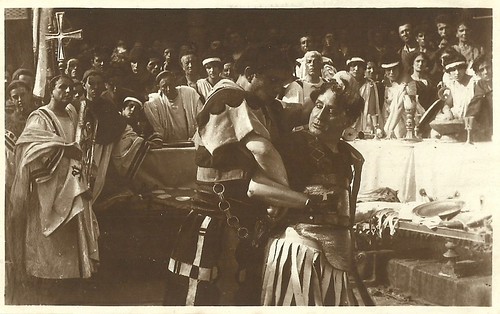
Italian postcard. Photo: Unione Cinematografica Italiana. Publicity still for La nave (Gabriellino D'Annunzio, Mario Roncoroni, 1921).
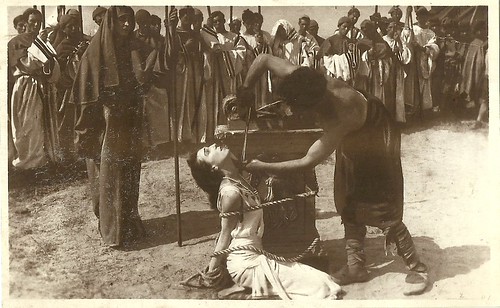
Italian postcard. Photo: Unione Cinematografica Italiana. Publicity still for La nave (Gabriellino D'Annunzio, Mario Roncoroni, 1921).
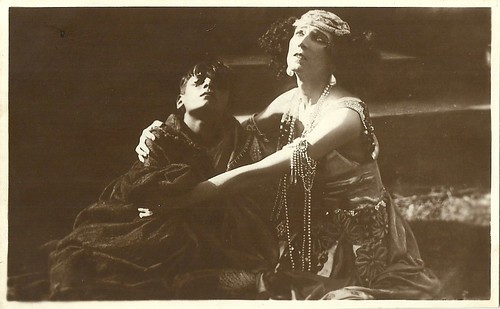
Italian postcard. Photo: Unione Cinematografica Italiana. Publicity still for La nave (Gabriellino D'Annunzio, Mario Roncoroni, 1921).

Italian postcard. Photo: Unione Cinematografica Italiana. Publicity still for La nave (Gabriellino D'Annunzio, Mario Roncoroni, 1921).

Italian postcard. Photo: Unione Cinematografica Italiana. Publicity still for La nave (Gabriellino D'Annunzio, Mario Roncoroni, 1921).

Italian postcard. Photo: Unione Cinematografica Italiana. Publicity still for La nave (Gabriellino D'Annunzio, Mario Roncoroni, 1921).
Russian dancer and actress Ida Lvovna Rubinstein (1883-1960) was a close friend of the poet and playwright Gabriele D'Annunzio. Rubinstein had made her debut as Antigone before dancing in 1908 for a private performance of Oscar Wilde's Salomé in which she stripped nude for the Dance of the Seven Veils. In 1909-1911, she performed with Sergei Diaghilev's famous Ballets Russes. She danced the title role of Cléopâtre in the Paris season of 1909, and Zobéide in Scheherazade in 1910. Both exotic ballets were choreographed by Michel Fokine, and designed by Léon Bakst.
After these successes she started her own ballet company. Rubinstein staged and starred in Le Martyre de Saint-Sébastien (The Martyrdom of St. Sebastian) (1911), a poetic drama by Gabriele d’Annunzio, with incidental music by Claude Debussy, choreography by Fokine, and magnificent scenery and costumes by Bakst. For Paris audiences she embodied the erotic temptation of the East, a view enhanced by her unconventional private life, which included lovers of both sexes and posing nude for painters.
In 1921, Rubinstein played the lead of Basiliola in the film La nave/The Ship, directed by D'Annunzio's son Gabriellino and by Mario Roncoroni. The film was based on a play by D'Annunzio, which already had been turned into an opera and had been filmed in 1912 by the company Ambrosio, but without much success.
Guido Marussig, who had designed both the play and the opera, designed sets and costumes for the 1921 film. The directors shot the film in a style typical or the later silent epics in Italy, denying innovation in film language. Instead they focused on acting, set and costume design, harking back to earlier epics such as Cabiria, but adding cruelty and sadomasochism.
La nave is set in early medieval times. In the Venetian plains, at the town of Aquileia, Basiliola, daughter of the dethroned tribune Orso Faledro returns per ship and notices her father and brothers have been blinded by the Graticò brothers, of whom Marco (Alfredo Boccolini) is the new tribune and Sergio (Ciro Galvani) has become bishop.
Basiliola decides to ruin all involved. In an extended dance scene she seduces Sergio, the lecherous bishop. La nave contains the only moving images of Rubinstein dancing, and the dance scene owes a great deal to Wilde's and Strauss's' Salome.
Basiliola manages to have the soldiers arrested who were responsible for blinding her relatives. Through her femme fatale behaviour the men, locked in a pit, desire to be killed by her bow and arrows. She also manages to set up the brothers against each other, with the younger brother Marco killing his older brother Sergio. Marco, though, realises the danger of the temptress Basiliola and condemns her to be blinded too. After her death the whole community leaves by ship to escape the nearing barbarians and to found a new, Christian community on a nearby island, Venice.

Italian postcard. Photo: Unione Cinematografica Italiana. Publicity still for La nave (Gabriellino D'Annunzio, Mario Roncoroni, 1921).
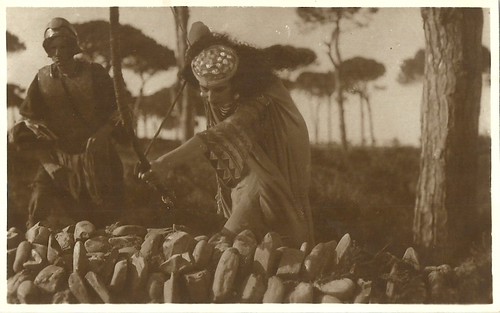
Italian postcard. Photo: Unione Cinematografica Italiana. Publicity still for La nave (Gabriellino D'Annunzio, Mario Roncoroni, 1921).

Italian postcard. Photo: Unione Cinematografica Italiana. Publicity still for La nave (Gabriellino D'Annunzio, Mario Roncoroni, 1921).
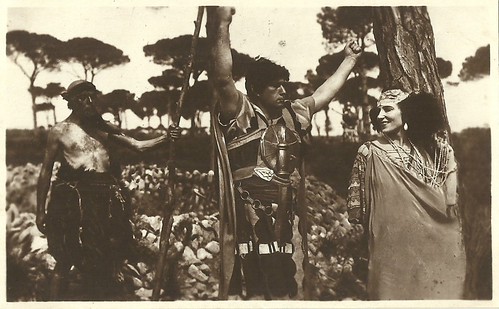
Italian postcard. Photo: Unione Cinematografica Italiana. Publicity still for La nave (Gabriellino D'Annunzio, Mario Roncoroni, 1921).

Italian postcard. Photo: Unione Cinematografica Italiana. Publicity still for La nave (Gabriellino D'Annunzio, Mario Roncoroni, 1921).
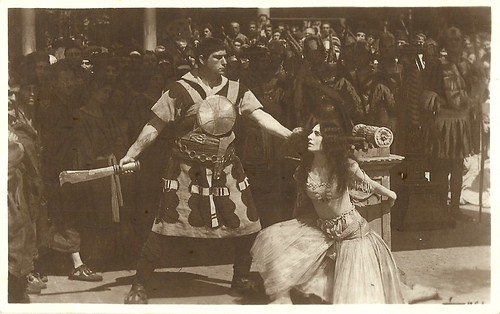
Italian postcard. Photo: Unione Cinematografica Italiana. Publicity still for La nave (Gabriellino D'Annunzio, Mario Roncoroni, 1921).
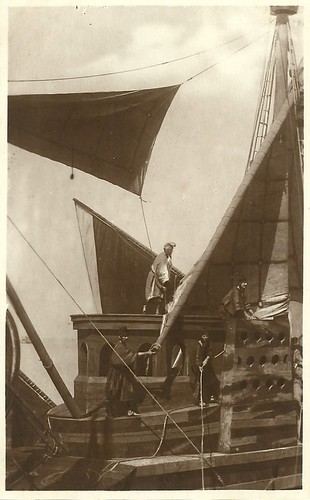
Italian postcard. Photo: Unione Cinematografica Italiana. Publicity still for La nave (Gabriellino D'Annunzio, Mario Roncoroni, 1921).
Sources: Jewish Women's Archive, Wikipedia (English and Italian), and IMDb.

Ida Rubinstein. Italian postcard. Photo: Unione Cinematografica Italiana. Publicity still for La nave (Gabriellino D'Annunzio, Mario Roncoroni, 1921).

Italian postcard. Photo: Unione Cinematografica Italiana. Publicity still for La nave (Gabriellino D'Annunzio, Mario Roncoroni, 1921).

Italian postcard. Photo: Unione Cinematografica Italiana. Publicity still for La nave (Gabriellino D'Annunzio, Mario Roncoroni, 1921).

Italian postcard. Photo: Unione Cinematografica Italiana. Publicity still for La nave (Gabriellino D'Annunzio, Mario Roncoroni, 1921).

Italian postcard. Photo: Unione Cinematografica Italiana. Publicity still for La nave (Gabriellino D'Annunzio, Mario Roncoroni, 1921).

Italian postcard. Photo: Unione Cinematografica Italiana. Publicity still for La nave (Gabriellino D'Annunzio, Mario Roncoroni, 1921).

Italian postcard. Photo: Unione Cinematografica Italiana. Publicity still for La nave (Gabriellino D'Annunzio, Mario Roncoroni, 1921).
Adding cruelty and sadomasochism
Russian dancer and actress Ida Lvovna Rubinstein (1883-1960) was a close friend of the poet and playwright Gabriele D'Annunzio. Rubinstein had made her debut as Antigone before dancing in 1908 for a private performance of Oscar Wilde's Salomé in which she stripped nude for the Dance of the Seven Veils. In 1909-1911, she performed with Sergei Diaghilev's famous Ballets Russes. She danced the title role of Cléopâtre in the Paris season of 1909, and Zobéide in Scheherazade in 1910. Both exotic ballets were choreographed by Michel Fokine, and designed by Léon Bakst.
After these successes she started her own ballet company. Rubinstein staged and starred in Le Martyre de Saint-Sébastien (The Martyrdom of St. Sebastian) (1911), a poetic drama by Gabriele d’Annunzio, with incidental music by Claude Debussy, choreography by Fokine, and magnificent scenery and costumes by Bakst. For Paris audiences she embodied the erotic temptation of the East, a view enhanced by her unconventional private life, which included lovers of both sexes and posing nude for painters.
In 1921, Rubinstein played the lead of Basiliola in the film La nave/The Ship, directed by D'Annunzio's son Gabriellino and by Mario Roncoroni. The film was based on a play by D'Annunzio, which already had been turned into an opera and had been filmed in 1912 by the company Ambrosio, but without much success.
Guido Marussig, who had designed both the play and the opera, designed sets and costumes for the 1921 film. The directors shot the film in a style typical or the later silent epics in Italy, denying innovation in film language. Instead they focused on acting, set and costume design, harking back to earlier epics such as Cabiria, but adding cruelty and sadomasochism.
La nave is set in early medieval times. In the Venetian plains, at the town of Aquileia, Basiliola, daughter of the dethroned tribune Orso Faledro returns per ship and notices her father and brothers have been blinded by the Graticò brothers, of whom Marco (Alfredo Boccolini) is the new tribune and Sergio (Ciro Galvani) has become bishop.
Basiliola decides to ruin all involved. In an extended dance scene she seduces Sergio, the lecherous bishop. La nave contains the only moving images of Rubinstein dancing, and the dance scene owes a great deal to Wilde's and Strauss's' Salome.
Basiliola manages to have the soldiers arrested who were responsible for blinding her relatives. Through her femme fatale behaviour the men, locked in a pit, desire to be killed by her bow and arrows. She also manages to set up the brothers against each other, with the younger brother Marco killing his older brother Sergio. Marco, though, realises the danger of the temptress Basiliola and condemns her to be blinded too. After her death the whole community leaves by ship to escape the nearing barbarians and to found a new, Christian community on a nearby island, Venice.

Italian postcard. Photo: Unione Cinematografica Italiana. Publicity still for La nave (Gabriellino D'Annunzio, Mario Roncoroni, 1921).

Italian postcard. Photo: Unione Cinematografica Italiana. Publicity still for La nave (Gabriellino D'Annunzio, Mario Roncoroni, 1921).

Italian postcard. Photo: Unione Cinematografica Italiana. Publicity still for La nave (Gabriellino D'Annunzio, Mario Roncoroni, 1921).

Italian postcard. Photo: Unione Cinematografica Italiana. Publicity still for La nave (Gabriellino D'Annunzio, Mario Roncoroni, 1921).

Italian postcard. Photo: Unione Cinematografica Italiana. Publicity still for La nave (Gabriellino D'Annunzio, Mario Roncoroni, 1921).

Italian postcard. Photo: Unione Cinematografica Italiana. Publicity still for La nave (Gabriellino D'Annunzio, Mario Roncoroni, 1921).

Italian postcard. Photo: Unione Cinematografica Italiana. Publicity still for La nave (Gabriellino D'Annunzio, Mario Roncoroni, 1921).
Sources: Jewish Women's Archive, Wikipedia (English and Italian), and IMDb.
No comments:
Post a Comment